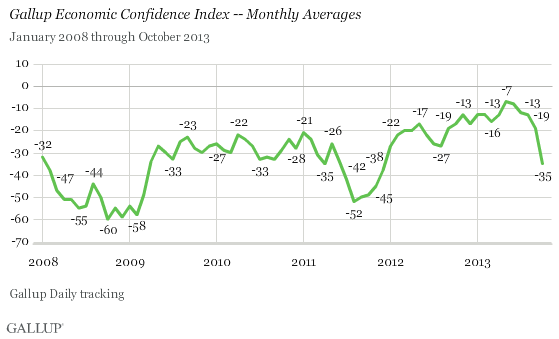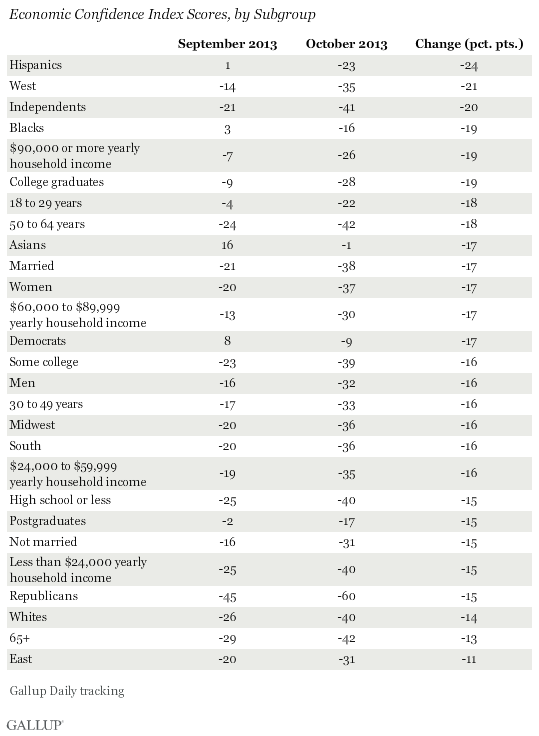WASHINGTON, D.C. -- Americans' confidence in the U.S. economy sank for the month of October amid the partial U.S. government shutdown and partisan bickering over the federal debt limit. For the entire month, Gallup's Economic Confidence Index was down 16 points, the sharpest monthly drop since Gallup began tracking economic confidence daily in 2008. Confidence improved after leaders in Washington reached a deal to end the shutdown, but it has not yet recovered to pre-shutdown levels.

The index in October is the lowest for an entire month since it registered -38 in December 2011, as Americans' confidence slowly recovered from the 2011 U.S. federal debt crisis and subsequent downgrading of the nation's credit rating. Confidence is significantly worse than it was in May of this year, when it reached -7, its monthly peak.
The Economic Confidence Index began to decline in mid-September, as the fiscal negotiations and partisan brinkmanship intensified. It plummeted to -34 in the first week of October as the partial government shutdown began on Oct. 1, registering the sharpest weekly decline since Lehman Brothers collapsed in September 2008, and grew worse the following week. Confidence slowly inched up after the government shutdown ended on Oct. 17, finishing at -29 for the week ending Nov. 3, but has not yet recovered to mid-September levels.
Confidence in Future Economy Falls Twice as Much as Views of Current Conditions
Gallup's Economic Confidence Index is based on two components: Americans' assessments of current economic conditions in the United States and their perceptions of whether the economy is getting better or worse. Both components soured last month during the shutdown, but Americans' economic outlook declined more than twice as much as their views of the current economic situation.
In October, 68% of Americans said the economy is getting worse -- the highest such percentage in nearly two years -- while 28% said it is getting better. This results in a net economic outlook score of -40, down 22 points from September.
By contrast, October's -29 net current conditions score -- based on 15% of Americans saying the economy is in excellent or good shape, and 44% saying it is poor -- is down 10 points from the prior month.
The result is that Americans' views of the economic future are worse than their views of the present for the first time since November 2011.

Confidence Declines Across All Major Subgroups
There were double-digit drops in confidence within all major demographic and socioeconomic groups in October, with every group more negative than positive toward the economy overall. Prior to the fiscal debates in October, confidence among blacks, Asians, Hispanics, and Democrats was in positive territory.
Confidence declined the most in October among Hispanics, those living in the West, and independents. At the other end of the spectrum, confidence slipped the least among those living in the East, adults aged 65 or older, and whites. September and October results by subgroup can be found on page 2.
Implications
Americans were less positive about the U.S. economy in October than they have been in nearly two years, with their ratings of current economic conditions and the economy's future course plunging. It is clear that partisan gridlock during the fiscal debates negatively affected Americans' economic views, regardless of their political leaning or socioeconomic status. While it is a positive sign that economic confidence slowly improved in the second half of the month, it has only partially recovered.
Although confidence dropped in October, the decline did not seem to affect Americans' self-reported spending. This suggests that that the drop in confidence was related more to Americans' evaluations of the political situation than the economic situation in the U.S. Perhaps more critical to the economy is not whether economic confidence worsens during intense partisan debates, but whether consumer activity in the form of spending is affected.
Gallup.com reports results from these indexes in daily, weekly, and monthly averages and in Gallup.com stories. Complete trend data are always available to view and export in the following charts:
Daily: Employment, Economic Confidence, Job Creation, Consumer Spending
Weekly: Employment, Economic Confidence, Job Creation, Consumer Spending
Read more about Gallup's economic measures.
View our economic release schedule.
Survey Methods
Results for this Gallup poll are based on telephone interviews conducted Oct. 1-30, 2013, on the Gallup Daily tracking survey, with a random sample of 15,319 adults, aged 18 and older, living in all 50 U.S. states and the District of Columbia.
For results based on the total sample of national adults, one can say with 95% confidence that the margin of sampling error is ±2 percentage points.
Interviews are conducted with respondents on landline telephones and cellular phones, with interviews conducted in Spanish for respondents who are primarily Spanish-speaking. Each sample of national adults includes a minimum quota of 50% cellphone respondents and 50% landline respondents, with additional minimum quotas by region. Landline and cell telephone numbers are selected using random-digit-dial methods. Landline respondents are chosen at random within each household on the basis of which member had the most recent birthday.
Samples are weighted to correct for unequal selection probability, nonresponse, and double coverage of landline and cell users in the two sampling frames. They are also weighted to match the national demographics of gender, age, race, Hispanic ethnicity, education, region, population density, and phone status (cellphone only/landline only/both, and cellphone mostly). Demographic weighting targets are based on the March 2012 Current Population Survey figures for the aged 18 and older U.S. population. Phone status targets are based on the July-December 2011 National Health Interview Survey. Population density targets are based on the 2010 census. All reported margins of sampling error include the computed design effects for weighting.
In addition to sampling error, question wording and practical difficulties in conducting surveys can introduce error or bias into the findings of public opinion polls.
For more details on Gallup's polling methodology, visit www.gallup.com.

